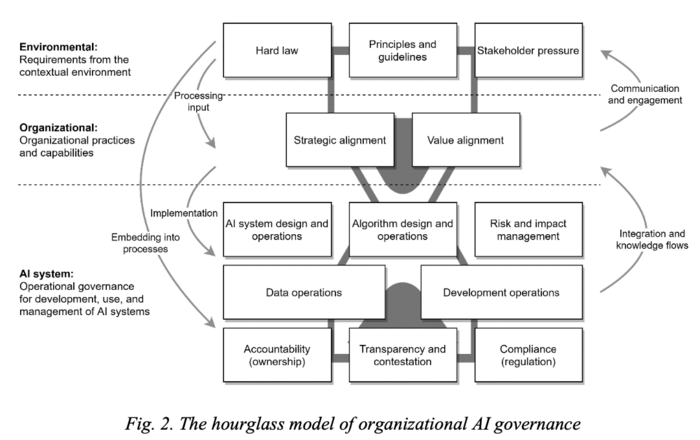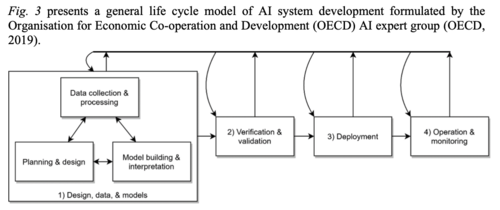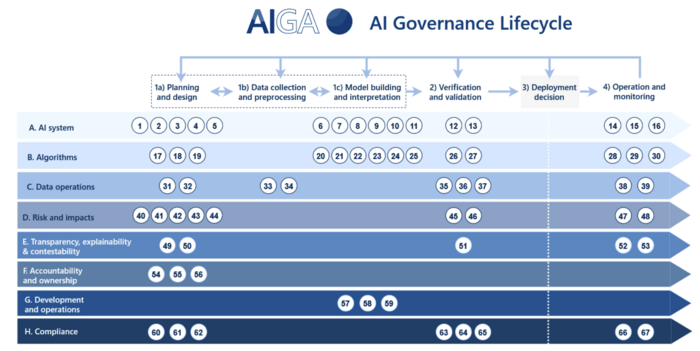KI-Governance
Glossar
- AI Governance
- AI Lifecycle
Integrated AI Governance
- AIGA: Artificial Intelligence Governance and Auditing Project Group, University of Turku, Finland
- Source: Mäntymäki, M., Minkkinen, M., Birkstedt, T., & Viljanen, M. (2022). Putting AI ethics into practice: The hourglass model of organizational AI governance (arXiv:2206.00335). arXiv.
- https://doi.org/10.48550/arXiv.2206.00335
- "AI governance is an emerging area of organizational practices, regulatory and ethical requirements, and commercial offerings."
- "Our research highlights the systemic, multilayered, and multi-stakeholder nature of AI governance (Minkkinen, Zimmer, et al., 2022; Zimmer et al., 2022)"
- Layers
- environmental requirements
- organizational practices and capabilities
- operational governance of AI systems
Environmental requirements
The environmental layer touches on technology and innovation policy (Stahl, 2022), AI ethics (Ibáñez & Olmeda, 2021), and regulatory studies (Kaminski & Malgieri, 2020; Viljanen & Parviainen, 2022)
Hard Law
Principles and Guidelines
Stakeholder pressure
Organizational practices and capabilities
- The organizational layer involves
- corporate governance (Harjoto & Jo, 2011),
- IT governance (Tiwana & Kim, 2015; Weill, 2008),
- and strategic management (Brendel et al., 2021), among others.
Strategic alignment
Value alignment
Operational Governance
- Operational governance for development, use, and management of Al systems
- The AI system layer involves fields such as
- software engineering (Dennehy & Conboy, 2018),
- critical algorithm studies (Kitchin, 2017; Ziewitz, 2016),
- and data governance (Abraham et al., 2019; Brous et al., 2016; Janssen et al., 2020).
Al system design and operations
Algorithm design and operations
Risk and impact management
Data operations
Development operations
Accountability (ownership)
Transparency and contestation
Compliance (regulation)
Commercial AI Governance Software
IBM
- IBM AI Governance Solution build on IBM Cloud Pak® for Data platform
- https://www.ibm.com/products/cloud-pak-for-data/ai-governance
- "Automate governance to provide trustworthy, explainable AI"
- Components
- Lifecylce governance: Catalog and monitor AI models with metadata capture, success identification and the ability to determine remediation initiatives.
- Risk management: Automate, identify, monitor and report on facts and workflows at scale, mitigating bias and drift to manage AI risk.
- Regulatory compliance: Translate external AI regulations into policies for automated enforcement. Use customizable dashboards to improve stakeholder collaboration.
- With this IBM solution, audits can become easier. You will be able to trace and
document the origin of data, the models and associated metadata, and the pipelines. The documentation will include the techniques that trained each model, the hyperparameters used, and the metrics from testing phases. You will benefit from having increased transparency into the model’s behavior throughout the lifecycle, knowledge of the data that was influential in its development, and the ability to determine possible risks.
AI Lifecycle
- building
- deploying
- monitoring
- centralizing facts for AI Explainability
AI Monitoring
for
- fairness
- quality
- drift
Definition von KI-Governance
- A. AI system
- B. Algorithms
- C. Data operations
- D. Risk and impacts
- E. Transparency, explainability, and contestability
- F. Accountability and ownership G. Development and operations H. Compliance
A. AI system
- Ensuring that the AI system is developed, operated, and monitored in alignment with the organization’s strategic goals and values.
- Literature
- Software development and project management (Dennehy & Conboy, 2018)
- Components & Tasks
- T1. AI system repository and AI ID
- T2. AI system pre-design
- T3. AI system use case
- T4. AI system user
- T5. AI system operating environment
- T6. AI system architecture
- T7. AI system deployment metrics
- T8. AI system operational metrics
- T9. AI system version control design
- T10. AI system performance monitoring design T11. AI system health check design
- T12. AI system verification and validation T13. AI system approval
- T14. AI system version control
- T15. AI system performance monitoring T16. AI system health checks
B. Algorithms
- Ensuring that the algorithms used by an AI system are developed, operated, and monitored in alignment with the organization’s strategic goals and values.
- Literature
- Software development and project management (Dennehy & Conboy, 2018)
- Critical algorithm studies (Kitchin, 2017; Ziewitz, 2016)
- Components & Tasks
- T17. Algorithm ID
- T18. Algorithm pre-design
- T19. Algorithm use case design
- T20. Algorithm technical environment design T21. Algorithm deployment metrics design
- T22. Algorithm operational metrics design T23. Algorithm version control design
- T24. Algorithm performance monitoring design T25. Algorithm health check design
- T26. Algorithm verification and validation T27. Algorithm approval
- T28. Algorithm version control
- T29. Algorithm performance monitoring
- T30. Algorithm health checks
C. Data operations
- Ensuring that data are sourced, used, and monitored in alignment with the organization’s strategic goals and values.
- Literature
- Data governance and data management (Abraham et al., 2019; Brous et al., 2016; Janssen et al., 2020)
- Critical data studies (Iliadis & Russo, 2016)
- Components & Tasks
- T31. Data sourcing
- T32. Data ontologies, inferences, and proxies T33. Data pre-processing
- T34. Data quality assurance
- T35. Data quality metrics
- T36. Data quality monitoring design
- T37. Data health check design
- T38. Data quality monitoring
- T39. Data health checks
D. Risk and impacts
- Identifying, managing, and monitoring potential risks and impacts caused by the AI system to align the system with the organization’s strategic goals and values.
- Literature
- Algorithmic impact assessment (Kaminski & Malgieri, 2020; Metcalf et al., 2021)
- Components & Tasks
- T40. AI system harms and impacts pre- assessment
- T41. Algorithm risk assessment
- T42. AI system health, safety, and fundamental rights impact assessment
- T43. AI system non-discrimination assurance T44. AI system impact minimization
- T45. AI system impact metrics design
- T46. AI system impact monitoring design T47. AI system impact monitoring
- T48. AI system impact health check
E. Transparency, explainability, and contestability (TEC)
- Ensuring that the AI system transparency, explainability, and contestability is aligned with the organization’s strategic goals and values.
- Literature
- Explainable AI (Barredo Arrieta et al., 2020; Laato, Tiainen, et al., 2022; Meske et al., 2022)
- Algorithmic transparency (Ananny & Crawford, 2018; Wachter et al., 2017)
- Contestability (Almada, 2019; Floridi, 2018)
- Components
- T49. TEC pre-design
- T50. TEC design
- T51. TEC monitoring design
- T52. TEC monitoring
- T53. TEC health checks
F. Accountability and ownership
- Ensuring necessary decision rights and responsibilities to govern the AI system and its algorithmic components to align the system with the organization’s strategic goals and values.
- Literature
- Algorithmic accountability (Martin, 2019; Shah, 2018; Wieringa, 2020)
- IT governance (Brown & Grant, 2005; Gregory et al., 2018; Tiwana & Kim, 2015; Weill, 2008)
- Components & Tasks
- T54. Head of AI
- T55. AI system owner
- T56. Algorithm owner
G. Development and operations
- Designing and implementing appropriate workflows and organizational structures for developing AI systems
- Literature
- Software development and project management (Dennehy & Conboy, 2018)
- DevOps (Gall & Pigni, 2021)
- MLOps (Mäkinen et al., 2021)
- Components & Tasks
- T57. AI development
- T58. AI operations
- T59. AI governance integration
H. Compliance
- Understanding the regulatory environment of an AI system and ensuring its compliance with the relevant regulations
- Literature
- Regulatory and legal studies (Kaminski & Malgieri, 2020; Viljanen & Parviainen, 2022)
- Components & Tasks
- T60. Regulatory canvassing
- T61. Regulatory risks, constraints, and design parameter analysis
- T62. Regulatory design review
- T63. Compliance monitoring design
- T64. Compliance health check design
- T65. Compliance assessment
- T66. Compliance monitoring
- T67. Compliance health checks
KI Markt
"The research firm IDC predicts the global AI market could reach over $500 billion by 2024—a more than 50% increase from 2021."
"50% of business leaders surveyed said meeting external regulatory and compliance obligations was the most important aspect of explainable AI."
"Most leaders haven’t yet taken the key steps toward establishing an AI governance framework. 74% are not reducing unintended bias."


